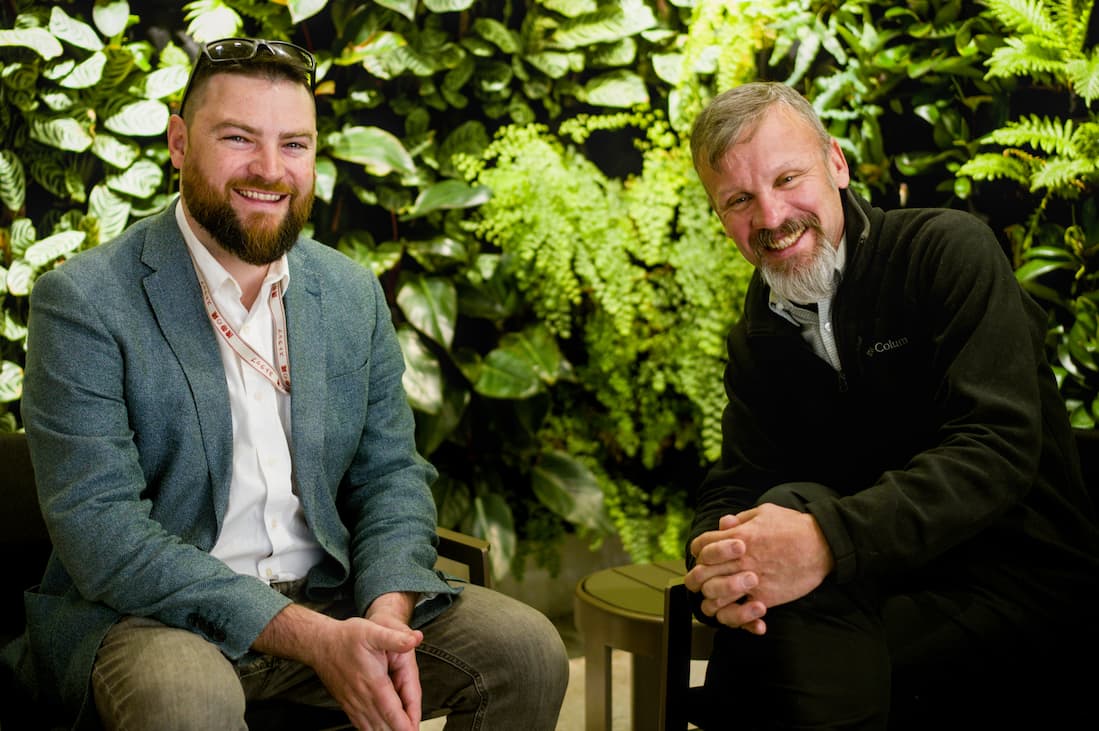
Living green walls can improve aesthetics, add a soothing touch of greenery to a space and lift our moods. But can they have a material impact on indoor air quality? Nick Johns-Wickberg investigates.
When architecture, horticulture, and interior design collide, you get a living wall. Done right, these vertical gardens can add much-needed greenery to dense urban areas and bring a touch of greenery to otherwise drab office spaces.
The benefits aren’t simply aesthetic, either. Living walls perform several valuable functions, as explored recently (“Vine intervention” by Laura Timberlake, March–April 2024 issue of Ecolibrium). If you haven’t read it already, make sure you check it out.
On the outside of buildings, living walls can provide extra thermal insultation, as well as a habitat for numerous species that would otherwise struggle to survive in built-up areas.
Thanks to research by the University of Technology Sydney (UTS), we also now know that green roofs can significantly improve the efficiency of photovoltaic systems by reducing operating temperatures.
But there’s one area in which living walls have perhaps fallen short: indoor air quality (IAQ). You’d think that dense, lush greenery would be effective in cleaning the air around us. But research has consistently shown that living walls (as most people know them) have somewhat limited capacity to filter indoor air and remove volatile organic compounds (VOCs).
Two academics from UTS are determined to change that.
Active living walls
Dr Peter Irga and Dr Fraser Torpy from UTS are researchers exploring technology known as “active living walls”. These are green walls attached to ventilation systems, where air is mechanically forced through plant and substrate matter. Those living materials act as a filter for particulate matter, VOCs, and carbon dioxide.
The team investigated the concept after it became clear that passive living walls (those without the ventilation component) wouldn’t provide significant air filtration.
“The idea behind green walls was that we needed to increase the amount of both plant and substrate surface area,” Irga says. “This is the best way to introduce the most plants into an indoor environment without taking space away from occupancy.
“Fraser pioneered the concept of active green wall technology on the back of researching indoor plants and volatile organic compounds. It came to a juncture where the effect (of passive living walls) was noticeable, but not enough that it was anything comparable to HVAC systems.
“‘How could we add technology to it?’ we wondered. So, we thought, ‘Let’s add some mechanically forced air through a green wall system’.”
That was the best part of 15 years ago. Since then, the team has learnt a lot more about what these systems can do and how they can be optimised.
Root cause
One of the team’s key discoveries has been the importance of the plant substrate in how active living walls function. For those who don’t have a green thumb, the substrate is the growing medium in which a plant establishes its roots. The most familiar of these is soil, but there are many other types of substrate, including coconut husks, pebbles, and peat.
The most effective filtration was observed when the team forced air past not just the plants and their leaves, but through the roots and the substrate.
“A substantial amount of R&D goes into the substrate itself, which resembles hydroponics,” Irga says. “We determined that, for plants to remove air pollutants and specifically volatile organic compounds, it’s actually the bacteria that grow on the roots that are most effective. But you need that symbiotic relationship – you can’t have just roots. You need the plants and the bacteria in the rhizosphere.”
The rhizosphere is the zone of soil surrounding a plant root where the biology and chemistry of the soil are influenced by the root. This zone is about 1 mm wide, but has no distinct edge.
Torpy adds that at this point, an active living wall can start to perform some of the functions typically reserved for complex ventilation and filtration systems.
“This is where we start to encroach on HVAC,” Torpy says. “Once we have the active airflow, what we’ve got looks like a filter, except it’s full of coconut husk rather than a filter matrix.”
It’s the results of this natural filtration system that have the researchers most excited.
Looks good, feels good
One of Junglefy’s major projects is a multi-storey carpark in Manly Vale, Sydney, that uses a breathing wall with 9,000 plants to remove air pollutants from car exhaust fumes. The system is designed to stop these pollutants from escaping out of the carpark and into the external environment; air is sucked from inside the carpark through the substrate and the plants, which face outwards. The project is a world-first – the breathing wall is modular and its panels rotate 180°, making it easy for maintenance staff to access the plants.
The company’s other marquee project is an indoor breathing wall system at Lendlease’s global headquarters in Barangaroo. Incorporating about 5,000 plants, the system filters the indoor air in the office building. Those pollutants the harm humans serve as food for the plants, helping them thrive.
Of course, aside from being practical, the systems also offer a touch of beauty to otherwise dull spaces in a way that traditional HVAC systems don’t.
“I am yet to see anyone stare at an HVAC vent and say how beautiful and calming they are,” says Junglefy general manager Nicholas Barr, “but your readers might prove me wrong on that one.”
Staying alive
Bringing any new technology to market is a challenge, as Junglefy – an Australian company pioneering active living wall technology – has discovered. The company has faced its fair share of challenges over the years, including disruptions in the supply chain and labour market during the COVID-19 pandemic.
“There are many barriers,” says Junglefy general manager Nicholas Barr. “Modern green walls started as a mostly aesthetic product 30 years ago, and since then they are often thought of as a ‘nice to have’ product.
“But ‘nice to have’ products look less appealing when you need to consider installation costs, ongoing maintenance, and taking building management and those in charge of OPEX on the journey of understanding that a green wall is not only a part of the building, but a living product. This is very important because the walls provide a service to those in the building and the wider community.”
Dr Fraser Torpy from the University of Technology Sydney believes that, while there’s still a long way to go to break through into the mainstream market, the technology can provide something new and much needed.
“As our cities are densifying, we become more and more urban, and our urban forests are taken away from us through development, we need to be looking at more solutions. This is a really simple, sustainable solution.”
Energy-efficient filtration
The team’s tests showed promising results in filtering a wide range of potentially harmful substances.
“We started testing other stuff that’s always been in the realm of HVAC, like suspended particulate matter,” Torpy says. “Going beyond HVAC, we then started testing for gaseous pollutants like nitrogen oxide and ozone.
“The results have been extremely encouraging, so we’ve just forged on.”
Torpy points out that energy efficiency is one of the key advantages of active living walls over traditional filtration systems. Rather than competing with one another, he suggests HVAC and active living wall technology can work together to produce excellent results.
“We can act as an adjunct now to HVAC, such that we reckon, based on all the proof of concept we have over 15 years, that we can make a difference to how much energy HVAC uses.
“Currently, HVAC removes gaseous air pollutants and carbon dioxide by ventilation. That’s really expensive. As we know, 40 per cent of the energy use in the built environment goes towards temperature control.
“We can reduce the load. We can do temperature, humidity, and particulate matter. Instead of expensive filters, we can pull that up in the plant substrate.”
A no-dilution solution
Irga and Torpy point out that, although traditional HVAC systems excel in certain areas, there are some substances within the air that they don’t deal with well.
“HVAC relies on the assumption that outdoor air is clean; it’s the dilution of outdoor air into the indoor environment,” Irga says. “What we’re not considering is air pollutants beyond particulate matter. HVAC systems typically just have a particulate matter filter and remove other air pollutants through dilution.
“All the gases that HVAC can’t remove except with dilution, we can draw down. We’ve tested the technology against cigarette smoke and got really good results. The most carcinogenic VOCs from cigarette smoke, the plants are able to reduce most efficiently.”
Given that external greening on buildings is becoming increasingly popular, the team proposes a solution that could nourish two birds with one handful of seed. They’re looking into the potential effectiveness of placing active living filters on the outside of buildings, instead of internally.
“We’re trying to find funding now to look at green roofs, such that the green roof would reduce air pollution and serve as a pre-filter before the air goes into the building,” Irga says. “This is an easy way to in-build sustainability on a building.
“You have all the co-benefits of a green roof, like biodiversity, thermal insulation, and improved photovoltaic performance if you have solar panels. And you reduce those air pollutants prior to the air even going into the building.”
It’s a jungle out there
Active living walls aren’t just in the prototype phase; there are companies around the world that design, install, and maintain the technology in situ.
Nicholas Barr is the general manager of Junglefy, one such company in Australia. Junglefy designs “breathing walls”, which function like the UTS team’s active living walls. In 2023, the brand was acquired by Vertical Gardens Australia, but still trades under the Junglefy name.
“People inherently need access to nature if we are going to keep living in increasing dense urban spaces,” Barr says. “Green infrastructure needs to be part of the conversation in our built environment. It’s important that these products work, can be maintained, and don’t cause greater issues with the buildings they are installed on.
“The big difference I see with Junglefy’s products and most other green infrastructure companies on the market is, yes, we put plants in and on buildings, but products like breathing walls actively contribute to the space and environment that they are in.”
We’re here, too
For Barr, raising awareness of Junglefy’s breathing walls in the building design process is key. He says Junglefy tries to take a proactive approach to communicating with HVAC and building services professionals.
“We want the best possible conditions for our product, so we often discuss the placement of our products and their interplay with HVAC and building management systems,” Barr says. “We like to discuss the way that plants transpire and what happens when inputs like grow lights and irrigation are introduced, so that sensors and management systems can understand what is happening.”
That communication is essential. When it falls through, things can go badly wrong.
“We need to know each other are there,” Barr says. “We have had issues when heat is blown directly onto and in close proximity to the walls.” This can damage or even kill the plants.
Stronger together
Barr believes deep collaboration between HVAC professionals and active living wall designers can provide the best outcomes for everyone. He identifies reducing the need for replacing filters – which are expensive and create waste that piles up in landfill – and capturing water drift on rooftops as two potential points of collaboration.
“We would love to find a way for green infrastructure products to help improve the effectiveness and efficiency of HVAC systems,” Barr says. “I would like to see a future where we can work more closely with HVAC designers and engineers to integrate our systems and products so we can use breathing walls, breathing stands and green roofs as part of the overall environmental control of buildings, and not as two competing factors.”
Torpy says the UTS team’s goal is to raise awareness amongst HVAC professionals and start collaborating on projects that can improve the sustainability of the built environment.
“As time goes on and we move towards net zero, HVAC is going to come under more pressure,” Torpy says. “HVAC is the number one user of energy in buildings. It can be better, and the solutions aren’t hard.”
“There’s the potential there to do this with relatively low cost and low effort. We can start pulling down this energy. There are sustainable solutions for HVAC.”

This article appears in Ecolibrium’s June-July 2024 edition
View the archive of previous editions
Latest edition
See everything from the latest edition of Ecolibrium, AIRAH’s official journal.





